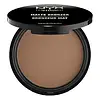What's inside
What's inside
 Key Ingredients
Key Ingredients

 Benefits
Benefits

 Concerns
Concerns

 Ingredients Side-by-side
Ingredients Side-by-side

Mica
Cosmetic ColorantPentaerythrityl Tetraisostearate
EmollientOctyldodecyl Stearoyl Stearate
EmollientBis-Diglyceryl Polyacyladipate-2
EmollientDimethicone
EmollientAluminum Starch Octenylsuccinate
AbsorbentDimethicone/Vinyl Dimethicone Crosspolymer
Skin ConditioningSilica
AbrasiveEthylhexylglycerin
Skin ConditioningTheobroma Cacao Seed Butter
EmollientPhenoxyethanol
PreservativeCI 77891
Cosmetic ColorantCI 77499
Cosmetic ColorantCI 77491
Cosmetic ColorantCI 77492
Cosmetic ColorantCI 19140
Cosmetic ColorantCI 15850
Cosmetic ColorantMica, Pentaerythrityl Tetraisostearate, Octyldodecyl Stearoyl Stearate, Bis-Diglyceryl Polyacyladipate-2, Dimethicone, Aluminum Starch Octenylsuccinate, Dimethicone/Vinyl Dimethicone Crosspolymer, Silica, Ethylhexylglycerin, Theobroma Cacao Seed Butter, Phenoxyethanol, CI 77891, CI 77499, CI 77491, CI 77492, CI 19140, CI 15850
Isohexadecane
EmollientPentaerythrityl Tetraisostearate
EmollientDisteardimonium Hectorite
StabilisingDimethicone
EmollientBeeswax
Emulsion StabilisingGlyceryl Behenate/Eicosadioate
EmollientTalc
AbrasiveCyclopentasiloxane
EmollientPropylene Carbonate
SolventSilica
AbrasiveMethyl Methacrylate Crosspolymer
Aluminum Starch Octenylsuccinate
AbsorbentDimethicone Crosspolymer
Emulsion StabilisingRosin
CI 77120
Cosmetic ColorantPhenoxyethanol
PreservativeAroma
Benzyl Alcohol
PerfumingBenzyl Benzoate
AntimicrobialBenzyl Salicylate
PerfumingHexyl Cinnamal
PerfumingHydroxycitronellal
PerfumingMica
Cosmetic ColorantCI 77891
Cosmetic ColorantIron Oxides
CI 77742
Cosmetic ColorantCI 15985
Cosmetic ColorantCI 19140
Cosmetic ColorantCI 15850
Cosmetic ColorantCI 45410
Cosmetic ColorantMethyl Methacrylate
Isohexadecane, Pentaerythrityl Tetraisostearate, Disteardimonium Hectorite, Dimethicone, Beeswax, Glyceryl Behenate/Eicosadioate, Talc, Cyclopentasiloxane, Propylene Carbonate, Silica, Methyl Methacrylate Crosspolymer, Aluminum Starch Octenylsuccinate, Dimethicone Crosspolymer, Rosin, CI 77120, Phenoxyethanol, Aroma, Benzyl Alcohol, Benzyl Benzoate, Benzyl Salicylate, Hexyl Cinnamal, Hydroxycitronellal, Mica, CI 77891, Iron Oxides, CI 77742, CI 15985, CI 19140, CI 15850, CI 45410, Methyl Methacrylate
Ingredients Explained
These ingredients are found in both products.
Ingredients higher up in an ingredient list are typically present in a larger amount.
Aluminum Starch Octenylsuccinate is a synthetic powder used as an absorbent, thickener, and anti-caking agent.
As an absorbent, it is great at mattifying skin by soaking up the oil. This is why you'll find it in a range of products from makeup to moisturizers.
This ingredient is considered a modified starch. Starch can also be found naturally in plants.
One study from 1991 found that 5% of this ingredient enhanced titanium dioxide SPF by as much as 40%. The study found 1% titanium dioxide had a 5.6 SPF and adding 5% of aluminum starch octenylsuccinate boosted it to an SPF of 8.1
Although “aluminum” in an ingredient name can raise red flags for some consumers, the form and usage context matter significantly. For typical topical applications, there is no substantial evidence of health risks - such as cancer, neurotoxicity, or systemic “aluminum overload.”
Learn more about Aluminum Starch OctenylsuccinateCi 15850 is the pigment color red. It is an azo dye and created synthetically.
Azo dyes need to be thoroughly purified before use. This allows them to be more stable and longer-lasting.
This ingredient is common in foundations, lipsticks, and blushes. This color is described as brown/orangey red.
It has many secondary names such as Red 6 and Red 7. According to a manufacturer, Red 6 usually contains aluminum.
Learn more about CI 15850CI 19140 is also known as Tartrazine. Tartrazine is a synthetic dye used in cosmetics, foods, and medicine to add a yellow color.
Tartrazine is created from petroleum and is water-soluble.
Some people may experience allergies from this dye, especially asthmatics and those with an aspirin intolerance.
Learn more about CI 19140Ci 77891 is a white pigment from Titanium dioxide. It is naturally found in minerals such as rutile and ilmenite.
It's main function is to add a white color to cosmetics. It can also be mixed with other colors to create different shades.
Ci 77891 is commonly found in sunscreens due to its ability to block UV rays.
Learn more about CI 77891Dimethicone is a type of synthetic silicone created from natural materials such as quartz.
What it does:
Dimethicone comes in different viscosities:
Depending on the viscosity, dimethicone has different properties.
Ingredients lists don't always show which type is used, so we recommend reaching out to the brand if you have questions about the viscosity.
This ingredient is unlikely to cause irritation because it does not get absorbed into skin. However, people with silicone allergies should be careful about using this ingredient.
Note: Dimethicone may contribute to pilling. This is because it is not oil or water soluble, so pilling may occur when layered with products. When mixed with heavy oils in a formula, the outcome is also quite greasy.
Learn more about DimethiconeMica is a naturally occurring mineral used to add shimmer and color in cosmetics. It can also help improve the texture of a product or give it an opaque, white/silver color.
Serecite is the name for very fine but ragged grains of mica.
This ingredient is often coated with metal oxides like titanium dioxide. Trace amounts of heavy metals may be found in mica, but these metals are not harmful in our personal products.
Mica has been used since prehistoric times throughout the world. Ancient Egyptian, Indian, Greek, Roman, Aztec, and Chinese civilizations have used mica.
Learn more about MicaPentaerythrityl Tetraisostearate is derived from isostearic acid. It is an emollient and emulsifier.
The highest concentration of this ingredient is found in lipsticks.
This ingredient is minimally water soluble and may not be Malassezia folliculitis, or fungal-acne safe.
Learn more about Pentaerythrityl TetraisostearatePhenoxyethanol is a preservative that has germicide, antimicrobial, and aromatic properties. Studies show that phenoxyethanol can prevent microbial growth. By itself, it has a scent that is similar to that of a rose.
It's often used in formulations along with Caprylyl Glycol to preserve the shelf life of products.
Silica, also known as silicon dioxide, is a naturally occurring mineral. It is used as a fine, spherical, and porous powder in cosmetics.
Though it has exfoliant properties, the function of silica varies depending on the product.
The unique structure of silica enhances the spreadability and adds smoothness, making it a great texture enhancer.
It is also used as an active carrier, emulsifier, and mattifier due to its ability to absorb excess oil.
In some products, tiny microneedles called spicules are made from silica or hydrolyzed sponge. When you rub them in, they lightly polish away dead skin layers and enhance the penetration of active ingredients.
Learn more about Silica